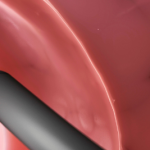Hepatitis B
Hepatitis B is a DNA virus and is responsible for the highest cause of chronic liver disease in the world, particularly in Africa, Asia and South East Asia.
Hepatitis B is a DNA virus and is responsible for the highest cause of chronic liver disease in the world, particularly in Africa, Asia and South East Asia. Chronic HBV is usually an asymptomatic disease. Most cases are acquired through neonatal vertical transmission. Horizontal transmission is usually by sexual exposure. 15% of chronically infected patients will develop chronic liver disease. Liver cancer occurs in 5% of long-standing hepatitis B cirrhotics. Most patients do not present until complications have developed.
Hepatitis B cases are divided into replicative and non-replicative types. Replicative types produce large amounts of virus and are generally e antigen positive and PCR-DNA positive. Some rare patients have a pre-core mutation which blocks expression of the e antigen. These patients may still have active liver disease with high levels of virus but are e antigen negative and PCR-DNA positive. Liver enzymes, particularly the ALT, may flare up during periods of immune activity against the virus. It is these recurrent necro-inflammatory attacks that cause liver damage. In patients who are highly replicative with e antigen positivity from birth, immune tolerance is often seen and there is no active inflammatory liver lesion. These patients do not usually develop liver fibrosis. The non-replicative type is usually associated with sero-conversion. This occurs when immune activity against the virus is successful. A conversion occurs to e antigen negative and e antibody positive. Hepatitis B PCR-DNA becomes negative. These patients are minimally infectious and generally have no active liver lesion. Their prognosis is good.
Investigations should be directed at assessing whether a patient is replicative or non-replicative by performing the hepatitis Be antigen, e antibody and measure their hepatitis B-DNA viral load. Elevated liver enzymes, particularly the ALT, indicate immune activity.
These patients have the best chance of clearing the replicative state. Advantage is taken of this in treatment regimes. All treatments are directed at inducing sero-conversion. It is very uncommon that the hepatitis B surface antigen carrier state is ever abolished.
The oral drugs Lamivudine, and more recently Adefovir, have a 30% chance of inducing sero-conversion over two years by inhibiting viral replication. The viral load is reduced and allows the immune system to overcome the reduced amount of virus. Interferon has a 30% sero-conversion response rate and may be used with a viral inhibitor. A four month course of Interferon can be more troublesome to patients with side-effects and this is usually reserved for second-line therapy. Long-term use of oral antiviral drugs can induce viral resistance (YMDD mutant strains). Liver biopsy to assess histological damage is usually required before commencement of a treatment programme. Patients with cirrhosis or severe liver disease can develop a severe flare of hepatitis with interferon treatment or if the oral antiviral agents are withdrawn. Liver transplantation is reserved for end-stage disease. The infection recurs in the graft liver.
Prevention is both by active and passive immunization at birth or to family contacts. A primary conventional vaccination programme stimulates adequate antibodies in 95% of patients. In cirrhotic patients, a monitoring programme for liver cell cancer is warranted. Annual ultrasound with a six monthly clinical examination and alpha-feto protein estimation is advised. Tumours less than 5 cm in diameter have a much better chance of cure with surgical resection.





